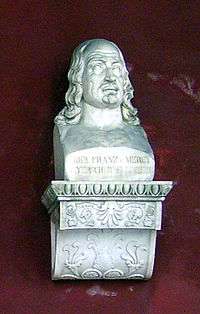Franz von Mercy
Franz Freiherr von Mercy (or Merci), Lord of Mandre and Collenburg (c. 1598 – 3 August 1645), was a German general in the Thirty Years' War who fought for the Habsburg side.


Biography
Franz von Mercy who came of a noble family of Lorraine, was born at Longwy some time between 1590 and 1598. From 1606 to 1630, he was engaged in the imperial service. By the latter year he had attained high military rank, and after distinguishing himself at the first Battle of Breitenfeld (1631) he commanded a regiment of foot on the Rhine and defended Rheinfelden against the Swedes with the utmost bravery, surrendering only after enduring a five-months' siege. He now became a general officer of cavalry in the rank of general-feldwachtmeister, and in 1635, 1636 and 1637 took part in further campaigns on the Rhine and Doubs.
In September 1638, the elector of Bavaria made him master-general of ordnance in the army of Bavaria, then the second largest army in Germany. In the next campaign he was practically commander-in-chief of the Bavarians, and at times also of an allied army of Imperialists and Bavarians. He was now considered one of the foremost soldiers in Europe, and was made general field marshal in 1643 when he won his great victory over the French Marshal Rantzau at the Battle of Tuttlingen (24–25 November), capturing the marshal and seven thousand men.
In the following year, Mercy opposed the French armies, now under the Great Condé and the Vicomte de Turenne. He fought, and in the end lost, the desperate Battle of Freiburg, but revenged himself the next year by inflicting upon Turenne the defeat of Mergentheim (Marienthal, Herbtshausen). Later in 1645, fighting once more against Enghien and Turenne, Mercy was killed at the Battle of Nordlingen (or Allerheim) at the crisis of the engagement, which, even without Mercy's guiding hand, was almost a drawn battle. He died on 3 August 1645. On the spot where he fell, Enghien erected a memorial, with the inscription Sta viator, heroem calcas.
Marriages and issue
Mercy was married three times. His first wife was Anna Margareta Bonn von Wachenheim who died around 1628 and made Mercy her sole heir. In 1630, Mercy married Anna Margareta von Schauenburg († 1636), a daughter of Johann Rainer von Schauenburg, the Landvogt of Ortenau. They had at least one daughter, Claudia (1631 – 1708) who later married Graf Bonaventura von Fugger (1619 – 1693), the first son of Otto Heinrich Fugger. The last wife of Franz von Mercy was Maria Magdalena von Flachsland who gave birth to most of his children, including three sons and one daughter who survived their childhood. All sons joined either the Austrian or the bavarian military. The first son Max Leopold inherited Mercys own Bavarian Regiment and later became imperial Generalfeldwachtmeister. The second son Peter Ernst von Mercy died in Austrian service deadly wounded in the Siege of Buda 1686, his son was Count Claude Florimond de Mercy, generally recognized as the last male descendant of Franz von Mercy. The third son Ferdinand Franz died in 1683 as commander of the Bavarian fortress of Ingolstadt.[1]
Notes
Regarding personal names: Freiherr is a former title (translated as Baron). In Germany since 1919, it forms part of family names. The feminine forms are Freifrau and Freiin.
References
- Pechtl, Andreas (2009): Nochmals Grimmelshausens „tapferer General“ Franz von Mercy. Anmerkungen und Ergänzungen zum Beitrag von Martin Ruch. Simpliciana, XXXI, Frankfurt am Main: Peter Lang, pp. 479–504.
